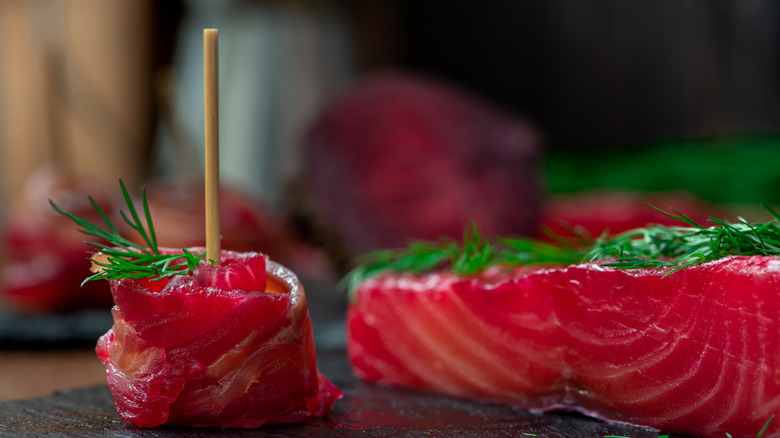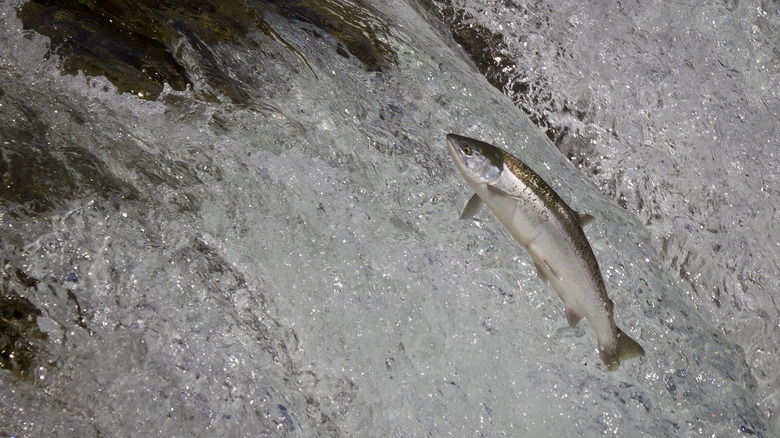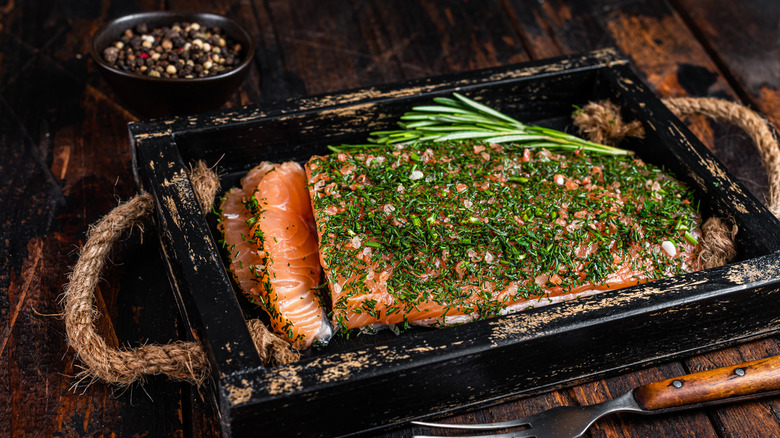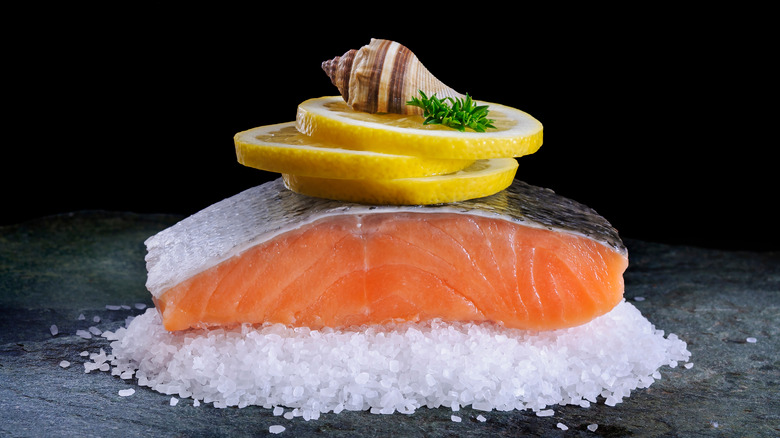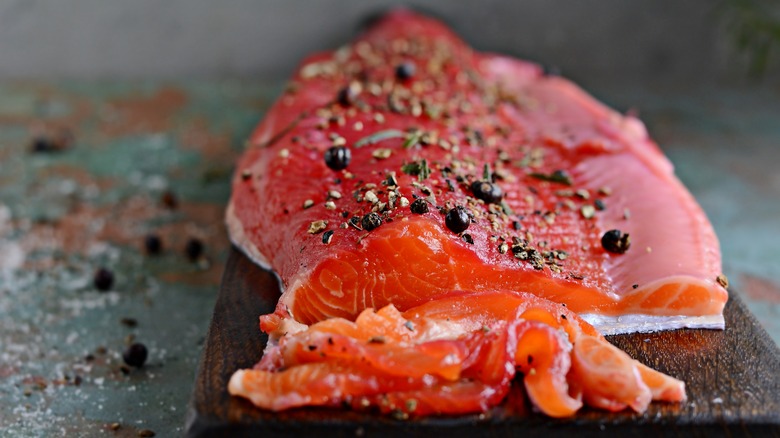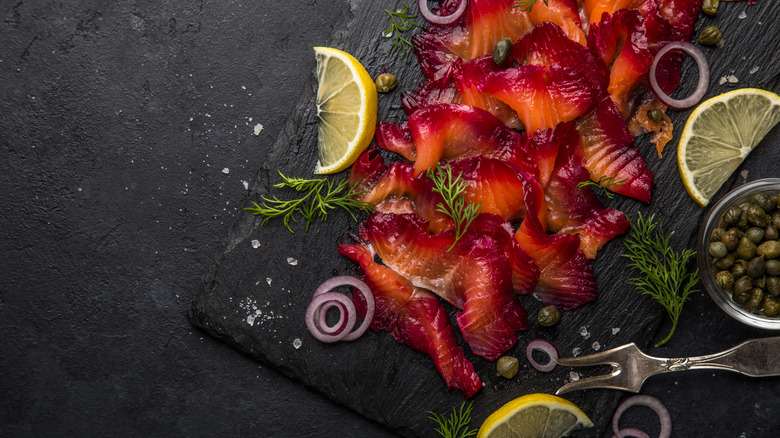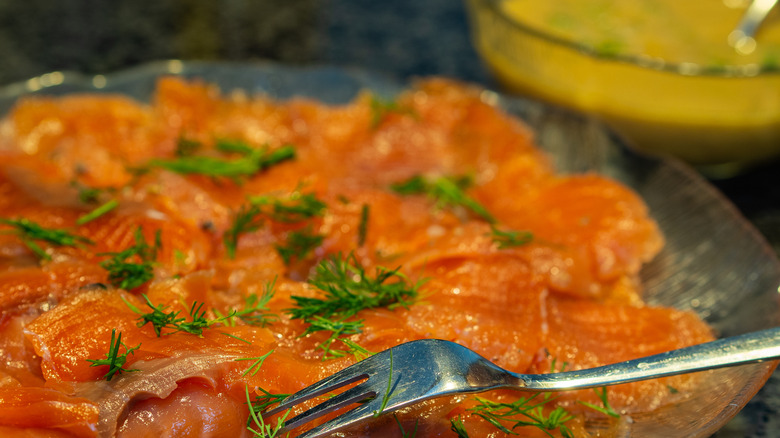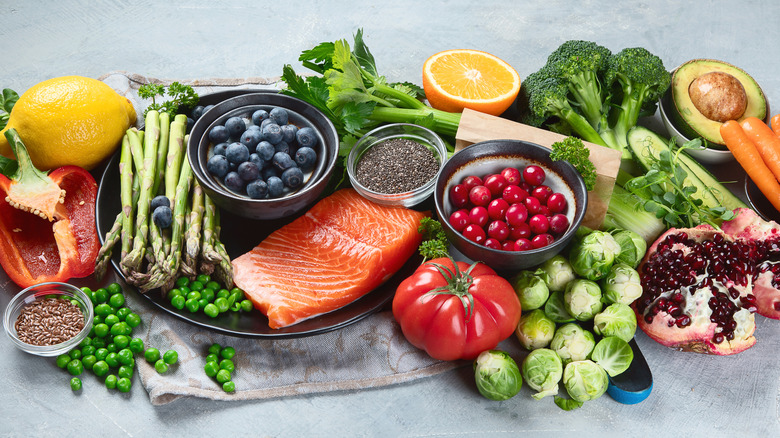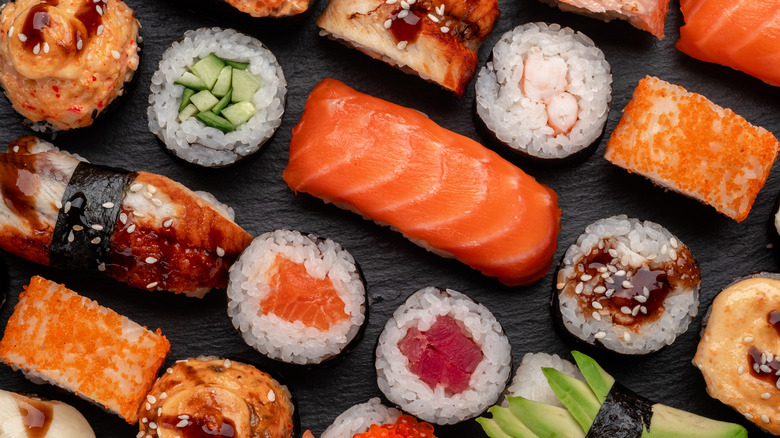Everything You Need To Know About Norwegian Gravlax
Salmon is a robust, large fish that thrives in the northernmost seas of the Pacific and Atlantic oceans. The scientific names are Salmo salar for Atlantic salmon and Oncorhynchus for Pacific salmon, with each sub-category having its own specific scientific name (Britannica). Saltwater fish by nature, salmon are anadromous and travel inland via freshwater rivers during spawning season (via NOAA Fisheries). Salmon is a popular and healthy culinary staple found on menus and in kitchens across the globe. It is delicious when grilled, smoked, cured gravlax, and raw as tartare or sashimi.
According to the famed chef Andreas Viestad, author of the Norwegian-focused culinary cookbook "Kitchen of Light New Scandinavian Cooking," gravlax means "buried salmon" because the fish is buried in a mixture of salt, sugar, aquavit, and herbs for curing. The first gravlax-style fish was wrapped in birch bark and buried in the ground for months, resulting in a nearly-rotten fermented fish that is now called rakfisk. While this is still crafted, the modern palate prefers gravlax's subtler flavors.
Norwegian salmon is considered a benchmark of quality, making it the perfect choice for gravlax. Before the advent of refrigeration, people needed ways to preserve food for long-term storage, particularly through the winter months. The purpose of curing is to preserve meats, per Great British Chefs. The salt, sugar, and spirits draw out the juices from the fish (via Bon Appétit) while the herbs add pleasant aromatic qualities elevating the flavors of the final dish.
Salmon thrives in icy arctic waters
There are eight types of salmon (via Britannica), and they all thrive in cold waters. The Pacific Ocean has six species. King or chinook salmon (O. tshawytscha) is the largest and fattiest Pacific salmon, and it is also an adventurous breed. Its habitat ranges from Alaska to southern California. Sockeye salmon (O. nerka) is a smaller fish than King salmon and is noted for its vermilion hue and pungent flavor. Native to Alaska, the fish is prized by gourmands when it is seasonally released each summer from June to July, per Whole Foods. Both breeds are perfect for gravlax.
Alaskan Coho salmon (O. kisutch) have delicate textures and flavors. They have silver scales giving them the nickname silver salmon. Alaskan coho is found in the waters near Alaska. Pink or humpback salmon (O. gorbuscha) and Chum salmon (O. keta) are low-fat, mildly-flavored fish (per Britannica). Both varieties are commonly processed and sold as frozen filets. Pink humpback salmon is the most abundantly-fished salmon. Chum salmon roe is robust and flavorful, making it a popular choice for a caviar-style substitute, per Allrecipes.
Atlantic salmon rarely appear in the wild due to centuries of over-fishing, but it is widely farm-raised for commercial purposes. NOAA Fisheries indicates that there are three types of Atlantic salmon: Baltic, European, and North American salmon. Each salmon can be made into gravlax but remember to use the best quality and freshest fish you can find, per the Los Angeles Times.
Gravlax is easy to make but requires patience
PBS's "New Scandinavian Cooking" star, Chef Andreas Viestad, and author of "Kitchen of Light New Scandinavian Cooking," starts with a traditional gravlax recipe that includes salt, sugar, pepper, dill, and dill seeds. Alternatively, his spicy gravlax recipe adds aquavit spirits, caraway seeds, aniseed, juniper berries, red pepper flakes, and the necessary salt and sugar combination. The herbs and spices are ground with a mortar and pestle into a coarse dust and blended into the salt and sugar mix. Once the salmon filets are cleaned, washed, and patted dry with paper towels, the curing blend is gently rubbed into the meat.
The meat is then drizzled with aquavit. Place one filet skin side down on plastic wrap and the other meat side down on top of the first. Tightly wrap the entire fish in plastic and place the fish in a heavy baking dish. Top the fish with a heavyweight (plates or a saucepan) and refrigerate it for four days, turning it every twelve hours. After curing is complete, carefully unwrap the gravlax and drain off any fluid before freshly wrapping the gravlax to freeze (via New Scandinavian Cooking). To present the gravlax for a meal, the herbs and curing blend are removed, and the chilled fish is sliced paper thin.
The science behind curing fish
New Scandinavian Cooking indicates that the salmon is cut lengthwise into filets and cleaned before the curing process begins. Gravlax requires a specific curing blend of salt, sugar, spirits, and herbs. The salt, sugar, and spirits are the impetus for curing the fish, thus preserving it. Bon Appétit reveals the curing process causes the salmon filet to lose up to 15% of its weight because the curing mixture draws the juicy fluids from the fish, condensing the meat and concentrating the flavors. The salt extracts the fluid and the sugar maintains the soft texture of the fish, per ScandiCuisine.
The Spruce Eats recommends using sushi-grade salmon or flash-freezing the salmon filets to kill any parasites that may be lurking in the meat. Andreas Viestad, author of "Kitchen of Light New Scandinavian Cooking," suggests waiting to freeze the salmon until after it is cured to maintain its texture. Freezing fresh salmon breaks down some of its proteins, affecting its texture. Once cured, gravlax can be frozen for a week to ensure all parasites are eliminated.
Gravlax has concentrated flavors
The Los Angeles Times reports that the salt and sugar curing process concentrates the flavors of the fish by extracting the juices from the fish and denaturing (cooking) the proteins. A similar denaturation occurs when using acidic juice to cure ceviche (via Eat With Us). As the flavors concentrate, the texture of the fish changes, too, becoming slightly firmer. If left to cure too long or using too strong a curing blend, the fish can become rubbery.
Salmon is a pungent fish to begin with and cured salmon even more so. Gravlax is flavorful so use it sparingly (per the Los Angeles Times) to enhance the rest of the dish. Its potent flavor and vibrant hue make gravlax a beautiful accent to canapés, smørbrød Scandinavian open-faced sandwiches, bagels with cream cheese served with a slice of red onion and chives, and as a topping for eggs Benedict. Try gravlax blended into creamy pasta dishes or sprinkled in a salad.
Get creative with gravlax
The Washington Post suggests getting creative with ingredients when preparing gravlax. Traditional recipes using aquavit and dill are delicious, but with access to herbs, spices, and spirits from across the globe, why limit yourself? Create exciting gravlax recipes using complimentary flavors that you enjoy. Start with the spirit of your choice such as gin, whisky, or an anise-flavored liqueur (think Pastis), and add aromatic herbs and spices to create unique flavor profiles to match your tastes.
The Washington Post suggests incorporating everything from fennel fronds, tarragon, garlic, basil, chile, coriander, thyme, and peppercorns, to beets, dried edible flowers, tea leaves, and cherry juice, into your gravlax recipe. When it comes to gravlax, the choices are endless. Keep in mind that traditional gravlax is crafted specifically from salmon. Still, the curing process can be used for other types of fish including trout, halibut, mahi mahi, striped bass, and mackerel, suggests the Los Angeles Times.
Cure your gravlax craving quickly
Gravlax is easy to make. All you need is salmon, a curing mixture of salt, sugar, spirits, herbs, and spices, a heavy dish, a weight to press the fish during the curing process, and three to four days (via New Scandinavian Cooking). To cure your gravlax craving quickly, look to your local food market. Gravlax is available in many grocery and specialty stores in the seafood department shelved next to smoked salmon, jars of crab and lobster, and packages of surimi imitation crab.
Look for house-crafted or packaged gravlax in fish markets, Jewish appetizing shops, some IKEA stores, and Scandinavian food markets like Willy's Products Scandinavian Food Store. Gravlax is also sold directly by producers like John Ross and Markys in their online stores. An online search for ready-made packaged gravlax turns up dozens of options that are available for purchase and fast delivery. Look for imported gravlax brands from Norway, Scotland, England, Alaska, New England, and Canada. Some brands even promise wild-caught salmon.
Gravlax is healthy
Salmon is a healthy source of protein. It is rich in omega-3 fatty acids, touted as the answer for everything from shiny locks and improved skin (via Healthline) to a healthy heart and brain. In a separate report, Healthline states that salmon might be one of the most nutritious foods of all. A 3 oz. portion of salmon has more than the daily recommended allowance of healthy omega-3 fats.
Wild salmon is richer in essential vitamins and minerals. Salmon is packed with B vitamins, including high levels of B12, necessary for energy and vitality. It is full of selenium, a trace mineral necessary for optimal endocrine function. It rivals bananas for potassium content, which is important for blood pressure stability and preventing edema. Salmon owes its red color to the carotenoid (carrots) antioxidant called astaxanthin, essential for preventing clogged arteries and heart disease. Additionally, wild salmon has more lean protein and slightly less fat, while farm-raised salmon tends to be higher in fats and calories.
While salmon is healthy, gravlax is salt and sugar cured and is still higher in sodium than fresh salmon, per Emozzy. Keep in mind that wild and farm-raised salmon contain toxins and mercury found in polluted waters, and farm-raised salmon may contain antibiotics, per Healthline. Microplastics are found in seafood like Pacific and Atlantic salmon and their habitats, reports Mother Jones.
Gravlax is just one way to prepare salmon
According to Food & Wine, there are three types of cured fish preparations: Gravlax, lox, and smoking salmon. Salt-brined lox is prepared from a belly-cut filet. The Honey Smoked Salmon brand has its product drizzled with honey, laden with spices, or served with cracked pepper. Salmon is also served raw and makes a delicious poke. Salmon tartare can be blended with lemon juice (via Allrecipes). Try it layered with avocado as a delectable appetizer. Salmon is found on sushi menus as sashimi, nigiri, or stuffed inside sushi rolls and flanked with pickled ginger and the heat of wasabi.
MasterClass suggests that there are many ways to cook salmon. Epicurious recommends a hearty salmon stew during the holiday season. Cooking Light suggests broiling, roasting, cooking salmon in parchment packets, or making salmon burgers. Allrecipes recommends baking, grilling, poaching, pan-frying, and even cooking salmon in an air-fryer. When it comes to salmon, the possibilities are endless. Think outside the box and try something adventurous like gravlax the next time you crave salmon.
